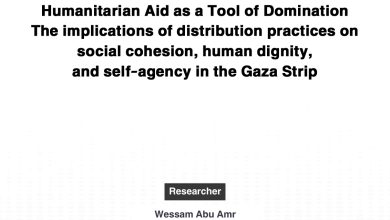New Release: Gaza Possible Outcomes of Egypt, Hamas, and Dahlan Talks

(Note: The paper was translated from an Arabic version published by ARI in September 2017.)
The latest talks between Egypt, Hamas, and Mohammad Dahlan, while rather unexpected, have reignited the debate about the future of the Gaza Strip. They also occurred in the larger context of renewed negotiations between the United States and Arab countries on ending the Palestinian-Israeli conflict and reshaping the region’s political map. However, the future of the Gaza Strip remains just as ambiguous. This paper presents four possible outcomes from these recent talks.
***
The latest round of talks between Egypt, Hamas, and Mohammad Dahlan reignited the debate about the future of the Gaza strip. These talks were somewhat unexpected given the growing rivalry and tensions between the three parties: Hamas, Mohammad Dahlan, and Egypt. Hamas, of course, has been in control of the Gaza Strip since June 2007. Mohammad Dahlan is the former official in Gaza for Fatah, a Palestinian liberation movement that has conflicted with Hamas in the past. Finally, Egypt has long considered Hamas an illegitimate actor tied to the Muslim Brotherhood. These discussions occurred in the larger context of renewed negotiations between the United States and Arab countries on ending the Palestinian-Israeli conflict and reshaping the region’s political map.
The new vision for the region has been influenced by three different visits to Washington, D.C.: The King of Jordan on 4 April 2017, the Egyptian president on 6 April 2017, and the Palestinian president, Mahmoud Abbas, in May 2017. During his visit, President Abbas assured the Palestinian and Arab diaspora that the heads of Arab states had a united view for the future of Palestine. Abbas came to Washington ready to discuss his vision of a Palestine within the 1967 borders with East Jerusalem as its capital with President Donald Trump.
However, this vision for a future Palestinian state can only be realized if the Gaza Strip is reintegrated into the Palestinian political structure. The rift between Gaza and the rest of the Palestinian Administration widened following the creation of Hama’s Administrative Committee in Gaza. Hamas claimed that the Palestinian Unity Government was failing the Gaza Strip and this committee was formed as a result. To that end, in April 2017, President Abbas announced that the Palestinian Authority would take concrete action to dissolve the Administrative Committee in Gaza and responded by reducing the salaries of Palestinian Authority employees in Gaza by 30%, and by cutting electricity in Gaza and ending financial support to the families of detainees held in Israeli jails. These actions were intended to exacerbate the pressures currently facing Gaza’s population, which are fueled by diminishing financial resources, the quasi-permanent closure of the Rafah border crossing with Egypt, and increased threats of military action from Israel. However, it is still unclear if Hamas will capitulate and dissolve the Administrative Committee. The future of the Gaza Strip is just as ambiguous, and there are various possible outcomes from the recent discussions between Hamas, Egypt, and Dahlan. This article will investigate four likely scenarios that could result from these talks.
Scenario 1
One possible outcome of the recent discussions could be the reconciliation of the various Palestinian factions leading to a unified Palestinian political system and a cohesive Palestinian society. Furthermore, the Administrative Committee would be dissolved allowing the Palestinian Unity Government to grow stronger and increase its influence over the Gaza Strip. This plausible unification would officially occur during a special session of the Palestinian National Council’s preparatory committee.
For the participants of the recent discussions, reconciliation is the only option for Hamas and Dahlan, as neither is recognized as a legitimate actor in both the regional and international arenas. In fact, both lack diplomatic representation to advocate for the interests of the Gazan population, authority over banks as well as the authority to issue passports, official documents, and salaries. Furthermore, they cannot fund or embark on strategic development projects, such as water desalination, electricity plants, or water treatment facilities. As a result, Hamas can never completely sever ties with the Palestinian Authority, even if their administration remains quasi-autonomous. On the other hand, even though Egypt is currently working to contain Hamas, it does not want to further divide the Palestinian people. Even opening the Rafah border on the demands of Hamas and Dahlan would be a large concession given Egypt’s policies on Hamas.
This first scenario would also require President Abbas to show unity among the Palestinian people to increase American support. This would ensure the American administration that Israel’s vision of a solution is a Palestinian state in Gaza, with Palestine conceding most of the West Bank in exchange for self-governance and political autonomy through separate cantons. This unity is also needed to withstand and confront pressures from the United States over ending all financial support to families of prisoners and martyrs.
Even though the different parties have yet to see eye to eye on the dissolution of the administrative committee to strengthen the Unity government. Despite the many failed attempts at reconciliation between these various parties over the past 10 years, it still remains the most advantageous outcome for all. Reconciliation would unite the West Bank, with its size and resources, and the Gaza Strip, with its geographic advantages and human resources. Additionally, an agreement between the actors would lend legitimacy to the Palestinian struggle and the authority of President Abbas. Furthermore, a reconciliation would give Hamas the opportunity to be accepted on the world stage, something they have been striving for. In fact, Hamas made a firm gesture towards cooperation by publicly accepting, for the first time, a Palestinian state within the 1967 borders in its most recent Document of Principles and Policies, which represents a major shift in Hamas’ policy.[1]
Finally, this scenario will require the diverse factions to cooperate and co-exist, Hamas and Dahlan’s goal, despite previously leaked comments referencing attempts to strip Abbas of his political authority. A rapprochement between Hamas and Dahlan will force the Palestinian Authority to make concessions to Hamas simply to distance itself from Dahlan. On the other hand, this situation, as well as pressure from Egypt, will likely force President Abbas to reconcile with Dahlan. Likewise, Egypt will assert its influence to prevent any alliances that could diminish Abbas’s authority and will actively work to distance Hamas from Qatar, Turkey, and Iran’s influence. Overall, Egypt’s interest is to dissolve the Administrative Committee and to strengthen the Unity Government’s influence over the Gaza Strip to set the stage for legislative and presidential elections.
[button color=”red” size=”medium” link=”http://www.arab-reform.net/en/file/2054/download?token=QwmkHRYT” icon=”fa-file-pdf-o” target=”false” nofollow=”false”]Download Pdf[/button]




